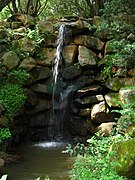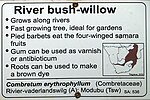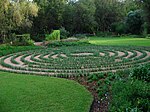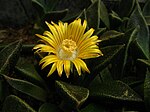North-West University Botanical Garden
History
The history of the North-West University Botanical Garden dates back to 1962 when dr. Wynand Louw, a botany lecturer, requested land from the then
Key functions and activities
The North-West University Botanical Garden fulfills many key functions within the
The Garden also provides may educational opportunities to visitors and the local community. Visitor friendly plant labels, emphasizing common plant names and plant uses, are used throughout the Garden.[1] The Garden also regularly supports community projects such as creation of school and community gardens.[1] In 2008 a partnerships was established with the North-West University Science Centre to also give local school groups exposure to the biological sciences during the annual National Science Week by providing suitable programming in the Botanical Garden.[1][6]
In 2008 an old hall in the office building, that once housed the
Plant collection


The North-West University Botanical Garden is located in Potchefstroom, in the Highveld region of South Africa. This region is characterized by cold dry winters with frequent frost and hot summers with regular thundershowers. Temperatures as low as minus 10 °C have been recorded in the Botanical Garden during winter.
Garden and theme gardens
Even though the North-West University Botanical Garden spans less than three hectares more than a 1500 plant species is found here.
Tropical greenhouse
In the tropical greenhouse a variety of tropical and subtropical plants from all over the world are present. Some of the plants include a variety of food and medicinal plants including
Succulent greenhouse
In the succulent greenhouse a variety of succulents and other
Gallery
-
North-West University Botanical Garden entrance
-
Students completing practical assignments in the Garden
-
Man-made waterfall in the Garden
-
Visitor friendly plant label
-
Low-maintenance Tulbaghia violacea maze/labyrinth
-
First flower of Victoria cruziana grown in 2010
-
Nananthus vittatus
-
Sculpture exhibition 2008
-
Bonatea polypodantha
-
Mystacidium capense
See also
References
- ^ a b c d e f g h i j k l Smit, Martin; Cilliers; Siebert; Willis (March 2011). "The North-West University Botanical Garden". Veld & Flora. 97 (1): 11–13.
- ^ a b "North-West University Botanical Garden". BGCI Plant Search Database. BGCI. Retrieved 21 August 2012.
- ^ "Botaniese tuin op kampus in gebruik geneem". PU-Kaner. February 1983.
- S2CID 45409345. Archived from the original(PDF) on 2013-05-06.
- ^ Scheppel, Kiewiet (10 March 2011). "Puk ensures survival of critically endangered plant". NWU News. Retrieved 21 August 2012.
- ^ Nel, Nikki (3 September 2010). "Volunteers learn how to plant trees". NWU News. Retrieved 15 September 2012.
- ^ Ciliers, Susan (21 February 2011). "Skaars lelie leef voort in Potch". Beeld.
- ^ Scheppel, Kiewiet (18 February 2011). "Puk grows impressive plant specie". NWU News. Retrieved 21 August 2012.












